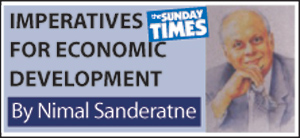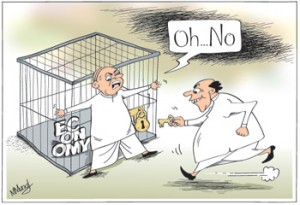Columns
Alternating economic policy regimes since Independence retarded development
View(s): Economic policies that alternated between regimes which were market oriented and ones that had much state control of the economy retarded economic development. Changing economic policies created uncertainties and perceptions of risk by investors. Furthermore, the inward looking import substitution policies and state control together with inefficient administration are important factors for slower growth.
Economic policies that alternated between regimes which were market oriented and ones that had much state control of the economy retarded economic development. Changing economic policies created uncertainties and perceptions of risk by investors. Furthermore, the inward looking import substitution policies and state control together with inefficient administration are important factors for slower growth.
However, no single explanation is sufficient to explain the moderate pace of economic growth. Rapid growth of population, adverse terms of trade, ethnic conflict, insurgencies and the civil war are among other explanations.
Independence to 1956
Till 1956, the government pursued policies with a minimum of state intervention. Accumulated foreign exchange reserves equivalent of about 9 months of imports and export earnings from tea, rubber and coconut enabled liberal trade policies. Land settlement and food crop agriculture were the central economic policies. A few state industries, such as cement, were established. A welfare package consisting of free health, free education and subsidised food was in place.
 A mixed economy 1956-65
A mixed economy 1956-65
In 1956, economic policies tilted towards greater state ownership and control of the economy. The Government nationalised bus services, insurance and the handling of port cargo. The Bank of Ceylon was nationalised and the People’s Bank was established as another state bank. Private foreign investment was discouraged.
The Government introduced a comprehensive agricultural strategy for food crop agriculture that consisted of a credit scheme, minimum guaranteed prices with government purchases of paddy and other food crops, a limited crop insurance scheme, subsidised fertiliser, an improved extension programme. It also attempted to ensure security of tenure and control share rentals on paddy lands.
With a fall in international prices for tea and rubber, foreign exchange reserves declined to crisis proportions. Consequently the Government pursued import substitution policies in agriculture and industry. Many imported commodities were banned. These policies failed to stimulate any significant industrial growth, but succeeded in increasing agricultural production.
Return to more liberal policies 1965-1970
There was a return to a free market economy during 1965-1970. The Government encouraged foreign investment and assured investors that their investments would not be nationalised, and if nationalised, that full compensation would be paid.
A dual exchange rate was introduced in 1966: Non-essential items were imported at a higher rate of exchange and non-traditional exports were entitled to a higher exchange rate and there was limited liberalisation in trade. The Government’s “Food Production Drive” gave a new impetus to food crop agriculture that achieved impressive growth.
Socialist regime 1970-1977
The 1970-77 period was characterised by greater state control, severe import restrictions, a failed import substitution policy and severe economic hardships. There was further tightening of exchange and import controls. The economy faced external and internal shocks. The insurrection of 1971 threatened to overthrow the Government. International prices of essential food imports (wheat, rice and sugar), petrol and fertiliser, coincided with drought and bad weather in the country. Scarcities of essential foods and basic commodities characterised these years.
A Business Acquisition Act was a threat to private enterprises being nationalised. Large tea, rubber and coconut estates were nationalised and private ownership of agricultural land was restricted to 50 acres per person, while ownership of paddy lands was restricted to 25 acres. There was also a ceiling in the ownership of houses.
Economic Reforms of 1977
In November 1977, the Government reversed economic policies by fundamental economic reforms that included the liberalisation of trade and exchange controls. It adopted an economic strategy dependent on export led growth, foreign investment, private investment and market forces. The exchange rate was unified, the rupee devalued and a floating exchange rate adopted.
These policy reforms relied on support from the IMF, World Bank and donor countries. It obtained considerable amounts of foreign aid and investment. There was a shift away from administered prices to market prices and reduction of food subsidies and welfare programmes. The lead economic development programme was the Accelerated Mahaweli Development Programme to increase agricultural production and enhance hydroelectricity. Other policies included an urban renewal programme, development of economic infrastructure and establishment of a Free Trade Zone.
These reforms transformed a closed, tightly controlled, inward looking economy into a market-oriented, outward looking one that gave importance to private enterprise and foreign investment. These economic reforms led to a high rate of economic growth till ethnic disturbances in July 1983 set back the economy. Terrorist attacks undermined business confidence, foreign investment and tourism and disrupted agriculture and fisheries in the North and East.
An insurgency in 1987 to 1989 seriously disrupted economic activity and economic growth fell. In 1988-89 growth averaged only 2.5 per cent. This weak economic performance led to the adoption of further structural reforms aimed at strengthening budgetary management, reducing inflation and improving the balance of payments and external reserves.
The economy was liberalised further after 1989 when the Government depreciated the rupee by about 17 per cent and cut budgetary expenditures by 20 per cent. Other reforms included the restructuring of the tax system to eliminate distortions and reduce tax on savings. The maximum corporate tax was reduced to 35 per cent, and personal taxation to 40 per cent. Export duties on tea, rubber and coconut were progressively reduced and ultimately eliminated.
By the end of 1993, 42 state enterprises were privatised and most state owned plantations were handed over to 22 companies for management. The two state banks were restructured to meet the capital adequacy requirements and restrictions on foreign investment in the Colombo Stock Market were removed.
Continuity with change 1994-2004
Despite a change of government in 1994, there was a continuity of economic policies for the first time since independence. The Government continued market-friendly open economic policies giving private enterprise the lead role in economic activity. Economic policy was characterised as “Open Economic Policies with a Human Face”.
The Government pursued “market-friendly” policies, liberalised trade further by decreasing tariffs, reduced corporate and personal taxes and gave further incentives for foreign investment. The government privatised, inter alia, the plantations, telecommunications, the Colombo Gas Co., the National Development Bank and Air Lanka. The change of leadership in 2005 brought about further changes in economic policies that will be discussed next Sunday.
Summing up
The political changes that brought about changes in economic policies is one explanatory reason for the moderate pace of economic growth over the sixty six post independent years.

